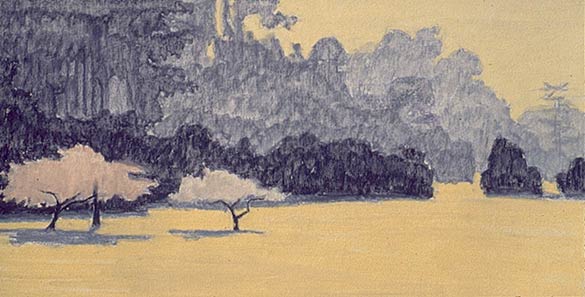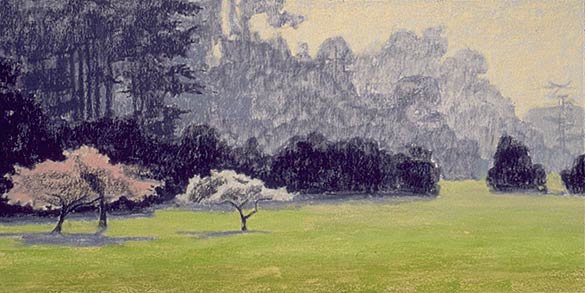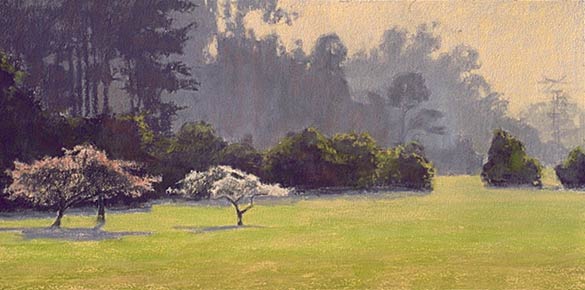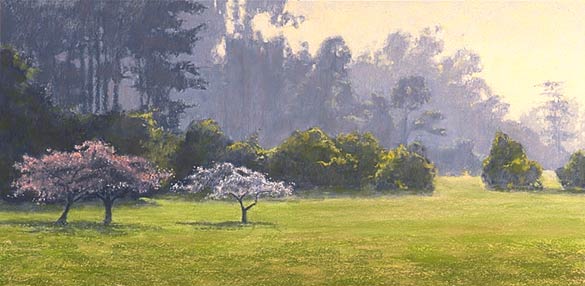
步骤1…自己做的位置画在蜡笔和石墨研究在素描簿来确定相对的价值观和比例,我开始工作在一个轻声的薄板的沃利斯沙纸装在博物馆的董事100%破布。我做一个轮廓图在彩色铅笔珩磨的形状,直到他在一起工作得很好。然后我填满每一个大块的颜色与柔和的,最好是一个或一个Nupastel幅霍尔拜因他们是很难的(不要留下太多的色素在原始表面)和更少的昂贵的比其他品牌。一个淡黄色的天空,一个类似的温暖的基调草将凉爽和绿色的整体。浅粉色一树,白色的其他。不同深浅的灰色蓝色的后退层树。我刷每Turpenoid和清洗刷子在移动到下一个颜色。结果是一个简单的平面和文摘版的我的场景,一旦干燥,告诉我如果我的价值观是正确的和形状有趣起来。

第二步……首先是覆盖着干颜料是草地上飞机,因为这是最“关闭”从完成的颜色。接下来我开始丰富的层次不同的树木,确保维持相对的价值。淡蓝色天空越过黄色给它降温,阴影进入盛开的树木开始给他们体积。

第三步……现场整体太酷。时间增加布朗,栗色,玫瑰和薰衣草的高大的树木,和淡橙色在草地上。阳光的颜色背景边缘的树木,和密集的颜料覆盖的白色纸,特别是后面的花朵盛开的树木,使它们“流行”。所有边缘附近是保鲜储藏格和更详细的加强对空间的感知。远处的物体离开故意软。

第四步……草是粗糙了最近的观众。精致的细节添加到盛开的树和最亲密的松树。也深绿叶蔬菜,使热树木自告奋勇。所有白色的痕迹从纸是分心覆盖。这个阶段需要最少的“做”和大多数时间观看。一个非常典型的下午在金门公园、旧金山。
原文如下:
Step 1... Having done location paintings in pastel and a graphite study in a sketch book to determine relative values and proportions, I get to work on an untoned sheet of Wallis sanded paper mounted on 100% rag museum board. I do an outline drawing in pastel pencil honing the shapes until they work well together. I then fill each large block with one color of pastel, preferably a Holbein or a Nupastel as they are hard (don't leave behind too much pigment on the raw surface) and less expensive than other brands. A light pale yellow for the sky and a similar warm tone for the grass which will be cool and green overall. Pale pink for one tree, white for the other. Varying shades of gray blue for the receding layers of trees. I brush each with Turpenoid and rinse the brush before moving on to the next color. The result is a simple, flat and abstract version of my scene, which, once dry, tells me if my values are correct and the shapes interesting together.
Step 2... First to be covered with dry pigment is the grass plane, as this is most "off" from the finished color. Next I start enriching the various layers of trees, making sure to maintain relative values. Pale blues go over the sky yellow to cool it down, and shading goes into the blooming trees to begin to give them volume.
Step 3... The scene overall is much too cool. Time to add brown, maroon, rose and lavender to the tall trees, and a pale orange in the grass. Sunshine colors on the edges of the backdrop trees, and denser pigment to cover the white of the paper, especially behind the blooming trees to make them "pop". All near edges are made crisper and more detailed to reinforce sense of space. Distant objects left intentionally soft.
Step 4... Grass is roughened up nearest the viewer. Fine detail added to blooming trees and to closest pines. Also deep greens to make the hot trees come forward. All traces of distracting white from the paper are covered. This stage takes the least amount of "doing" and the most time spent looking. A very typical afternoon in Golden Gate Park, San Francisco.








